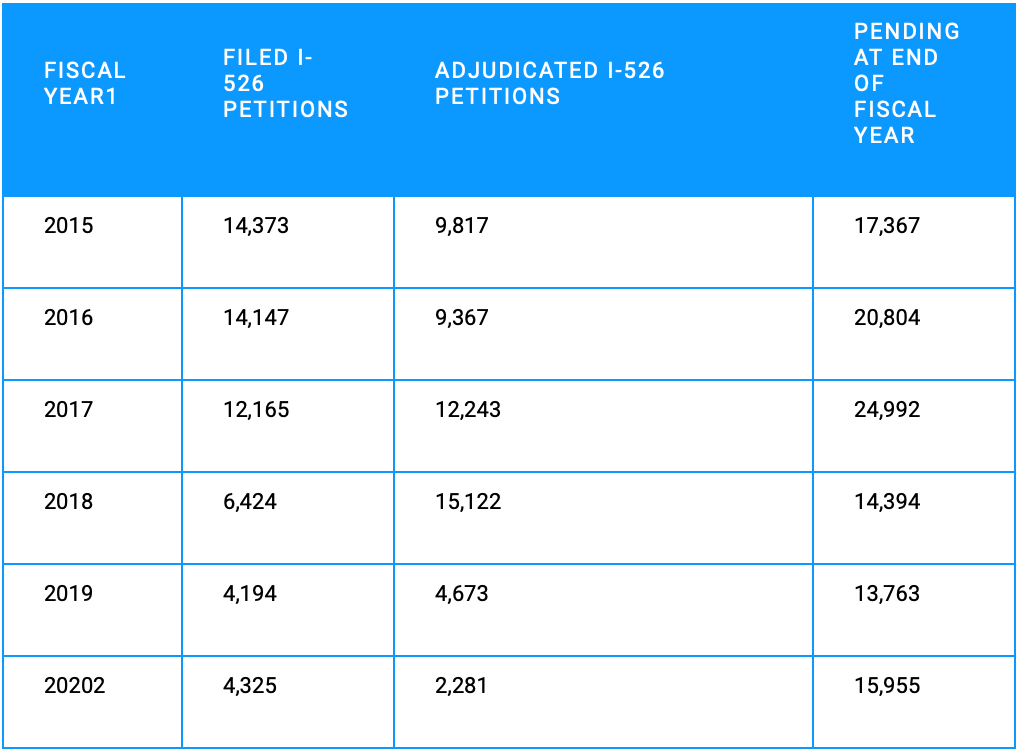What is an EB-5 visa?
The EB5 visa is a way to get a green card (permanent residency) through investment in the U.S. The EB-5 investor visa program enables foreigners who make an investment in a U.S. business to obtain a green card and become lawful permanent residents. The EB-5 visa program is operated by United States Citizenship and Immigration Services (USCIS). The program was established by the United States Congress in 1990 to facilitate increased investment in the U.S. economy. The investment can lead to a green card for the investor to permanently live and work in the United States with their spouse and unmarried children under the age of 21. Thereafter, you and your dependents may also become eligible and apply to be a citizen.

EB-5 Visa Investment Requirements
To meet EB-5 investor visa requirements, foreign investors must make an “at risk” capital investment in a for-profit U.S. business entity. The required investment amount is either $900,000 or $1.8 million, depending on the geographical location of the project you invest in. If you invest in a targeted employment area (TEA) the investment is $900,000, and if you invest elsewhere the minimum required investment is $1.8 million. EB-5 investments must lead to the creation of 10 fulltime U.S. jobs that exist for at least two years.
How Many EB-5 Visas Are Issued Each Year?
USCIS reserves approximately 10,000 visas for EB-5 investors each fiscal year. Due to a drastic increase in the number of EB-5 program participants since 2011, the EB-5 visa category has a long wait time for individuals of certain countries. This growth can be attributed to increased confidence in the program due to USCIS transparency, efficiencies in the application process, and growth in the number of regional centers established across the United States. Below is a chart of the number of filed and adjudicated I-526 petitions by USCIS each year, as well as the number of petitions which remain pending for processing with USCIS.

EB-5 Regional Center Investments
EB-5 investor visa applicants have two main investment options. Investors can either invest directly or through an investment sponsored by an EB-5 Regional Center. Direct investors must find their own investment project and do not benefit from the ability to count jobs indirectly using reasonable economic methodologies. Direct investment is best for those who want more hands-on control of their investment and the project that received their investment.
EB-5 investor visa applicants can also make an investment sponsored by an EB-5 Regional Center. This option may be best for those who are more interested in the immigration goals of EB-5 rather than obtaining a maximum return on their investment, and for those who do not wish to oversee the day-to-day management of their investment. Regional centers receive designation from USCIS to sponsor EB-5 investment projects. Regional centers are responsible for adhering to USCIS EB-5 program regulations. This can take the strain off of the investors so that they are not solely responsible for meeting program requirements. As a result, investment through regional centers suits those who want a more hands-off approach, where they are not responsible for the direct management of their investment. Over 95 percent of all EB-5 visas issued in 2019 were based on investments made through a regional center.
EB-5 Job Creation Requirements
According to USCIS, an EB-5 investment must preserve or create a minimum of 10 full-time positions for workers in the United States who qualify. This creation, or preservation, of jobs generally must occur within two years of the investor’s conditional permanent residency and entrance into the United States. Jobs created in EB-5 projects are defined as direct, indirect or induced. In the direct investment context, the EB-5 visa applicant must prove that the EB-5 capital resulted in the actualization of direct jobs of employees working directly in the business in which the investment was made (i.e. full-time, W-2 employees). In the regional center context, the applicant can count direct, indirect, and induced jobs toward the job creation requirement. Indirect and induced jobs are demonstrated by mathematical formulas which measure the economic impact of the EB-5 investment.
EB-5 Investor Visa Application Proccess Overview
EB-5 visa applicants must follow three general steps to obtain U.S. permanent residency:
- Invest in an individual business that will create 10 direct fulltime U.S. jobs per investor (direct investment) OR
Invest through a USCIS-designated regional center where the investor may create 10 direct, indirect and/ or induced jobs per investor. - Upon I-526 approval and provided there is no visa backlog applicable the investor’s country of birth, the investor submits their conditional permanent resident application either through the filing of an I-485, Application for Adjustment of Status, or DS-260, Application for Immigrant Visa. This is the petition that will confer the green card to the investor and his eligible dependents.
- Lastly, the investors must prove that all EB-5 requirements have been met at the end of the two-year conditional residency by filing the I-829 petition to remove the conditions of residency within 90 days prior to the expiration of their two-year period. The investor and their applicable dependents then receive an unconditional green card valid for 10 years.
What is the EB-5 visa processing timeline?
The first step is to file an I-526 Petition, which currently has an estimated processing time of 35 months to 52.5 months3, although the process is faster for those born outside of mainland China due to the visa availability approach for processing times.
Upon approval of the I-526 Petition, a foreign national can only move forward if a visa is immediately available to them based on their country of birth. Thus, the EB-5 processing timeline varies due to the country of birth of the applicant due to per country limitations on the number of visas which may be granted in each fiscal year.
Assuming a visa number is immediately available, if a foreign national is outside the U.S. they will file a DS-260, Immigrant Visa Electronic Application, with the National Visa Center, attend a visa interview at their local Consulate or Embassy, and thereafter enter the U.S. on an EB-5 visa. Upon entry to the U.S. on an EB-5 visa, the foreign national will receive their conditional green card. This process normally takes approximately 9-12 months but may be longer depending upon visa appointment availability at their local Consulate or Embassy.
If a foreign national is inside the U.S. in certain statuses, they can file a Form I-485, Application to Register Permanent Residence or Adjust Status, to adjust their status to that of a permanent resident. Upon approval of this application, the foreign national will receive their conditional green card. This process normally takes approximately 6-9 months but can be longer depending upon the area of the U.S. where the foreign national is residing.
21 months after receiving their conditional green card, the foreign national is eligible to file a Form I-829, Petition by Investor to Remove Conditions on Permanent Resident Status. This petition currently has an estimated processing time of 33 to 54 months,1 although foreign nationals who file mandamus lawsuits typically experience faster processing times. Upon approval of this petition, the foreign national will receive their unconditional green cards.
What is expedited I-526 processing (EB-5 visa fast)?
USCIS has the discretionary authority to grant expedited processing to any immigration application or petition on the basis of the following:
- “Severe financial loss to a company or person;”
- “Urgent humanitarian reasons;”
- “Compelling U.S. Government interests (such as urgent cases for the Department of Defense or DHS, or other public safety or national security interests); or”
- “Clear USCIS error.”
There is a very high bar to receive this discretionary grant. For instance, financial loss that was foreseeable or as a result of the immigrant’s actions typically is not looked upon favorably. By way of example, if an escrow agreement restricts the distribution of an EB-5 investors capital investment prior to petition approval, USCIS takes the position any financial loss as a result of this agreement is self-inflicted and therefore not appropriate for a favorable grant of expedited processing. Compelling government interest is also a high bar, typically requiring a U.S. government agency to support such a request.
If USCIS grants expedited processing based on any of the foregoing, USCIS will adjudicate the application or petition faster than normal processing times.
New EB-5 Regulations and EB-5 Legislation
On Nov. 21, 2019, new EB-5 regulations published by the Department of Homeland Security (“DHS”) increased the minimum investment amount in a TEA to $900,000 and the minimum investment amount for a non-TEA to $1,800,000. These regulations also set those amounts to be adjusted for inflation every five years tied to the CPI-U starting Oct. 1, 2024. The new regulations also included the following provisions:
- An investor with a prior approved I-526 Petition may retain the priority date associated with that petition, provided such I-526 Petition was not approved through fraud, willful misrepresentation of a material fact by the investor or because of a material error by USCIS. For instance, where a material change occurs (such as change to the applicable regional center or new commercial enterprise) and the I-526 Petition was previously approved, then an applicant may retain the priority date and file a new I-526 Petition based on the new facts. A priority date is not transferrable to another applicant. Applicants who have received an immigrant visa or approval of a I-485 Application are not eligible;
- Derivative beneficiaries will be allowed to file an I-829 Petition where the investor has failed to file or refuses to file an I-829 Petition on their behalf; and
- DHS has removed references to “management” of the new commercial enterprise and clarified that, generally, investors who have normal rights under a standard limited partnership agreement or limited liability company agreement will meet the EB-5 Program requirement of active involvement in the new commercial enterprise.
These new regulations have been the subject of two lawsuits in Federal Court and may change in the future depending on the outcome of those lawsuits. If these two lawsuits are successful, the regulations would likely be struck down and none of the above changes would be in effect. For instance, the investment amounts would revert to the prior amounts of $500,000 for a TEA and $1 million for a Non-TEA.
In addition to those lawsuits, legislation has been continually proposed in Congress to reform and revise the EB-5 Program. The portion of the program which authorizes the use of regional centers must be reauthorized by Congress and is not considered a permanent part of the EB-5 visa category. Thus, there will be opportunities for future legislation to change and amend the existing program. We encourage you to check our website for updates or contact your Immigration Attorney to obtain the latest information

